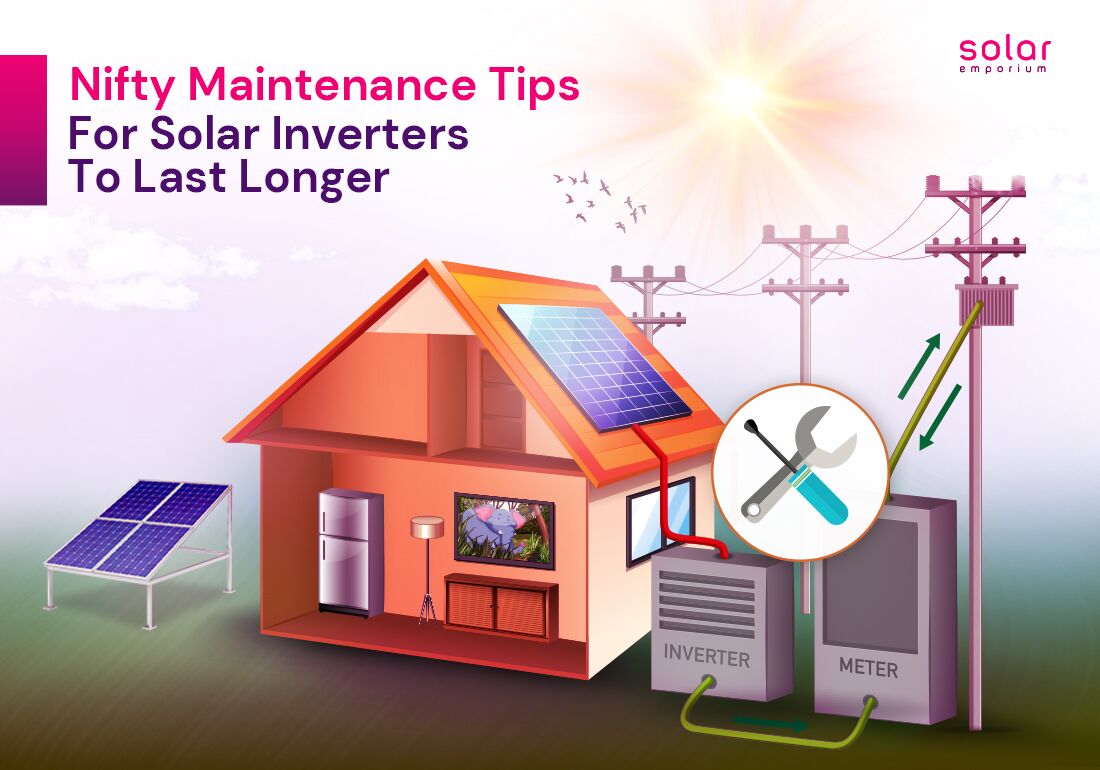A solar inverter is a vital component in your solar power system. A solar inverter converts your solar panels’ direct current (DC) energy into alternating current (AC) electricity. It can power your household appliances, lighting, and electronic devices.
When your inverter has issues, it hampers the connection of solar panels in your home. And it potentially leads to unexpectedly high utility bills.
So, how can you ensure the smooth operation of your solar inverter? And how can your solar inverter last longer? Therefore, here are some nifty maintenance tips for solar inverters to last longer.
We will also provide essential insights into your solar inverter’s maintenance, repair, and service information, which are significant in your solar power setup.
Signs of Inverter Failure
While solar panels usually last 25 years or more, solar inverters tend to have a shorter lifespan. Even the best solar inverters typically have warranties lasting 10 to 12 years. After the warranty period, you should mentally prepare yourself for a replacement.
Here are signs that your inverter may not be functioning correctly:
Unusually High Power Bill: If your inverter isn’t generating enough energy, you’ll get more electricity from the grid. And it will result in a spike in utility costs.
Error Messages: Error messages on the inverter’s display indicate a problem; contacting a certified solar technician is advisable to diagnose and address the issue.
No Indicator Lights: A lack of status lights or the presence of yellow, red, or flashing lights often indicates an issue with your inverter.
Solar Battery Doesn’t Charge: Some solar batteries rely on AC power from the inverter; it may signify inverter issues if the battery isn’t charging.
Disconnected Appearance: It likely requires repair if the inverter seems unconnected or damaged in its connections.
What Damages Inverters?
Overheating
Faulty Installation
Isolation Issue
Maximum Power-Point Tracking (MPPT) Problems
Inverter Restarting Issues
What to Do If Your Solar Inverter Fails
If your inverter experiences issues, you have several options for resolution:
Contact Your Solar Installation Company:
Contacting the company that installed your solar system is helpful. They can assess and potentially repair or replace the inverter.
Contact the Inverter Manufacturer:
If the installer is no longer available, contact the manufacturer for assistance. They may send a technician or collaborate with a local solar company to address the problem.
Consult a Trusted Solar Company:
You can also contact an established and reputable solar company, like Solar Emporium, to resolve any inverter issues. Providing documentation from the installation can speed up the process.
Maintenance Tips For Solar Inverters To Last Longer
Location
Ensure your inverter system’s installation is in a well-ventilated, dust-free environment. It would save you a lot of money. It may overheat when you install it in an area with no ventilation. The heat forms dew, which can lead to rust. Preventing heat, moisture, and dust will help your inverter system run more efficiently.
Also, install your inverter sheltered to protect it from rain, snow, and direct sunlight. Environmental exposure can cause damage and reduce efficiency. Check for water flow and corrosion regularly.
Overloading the Inverter
Maintain Proper Ventilation
As the inverter converts DC electricity to AC, it generates heat. Keeping at least twelve inches of open space around the equipment is recommended to ensure proper airflow. Avoid blocking the inverter’s fan.
Additionally, keep flammable items away from the inverter to prevent fire hazards.
Clean the Air Intake Filter
Check for Error Codes
Utilise Solar Monitoring Technology
If your solar power system includes monitoring technology, such as a smartphone app, use it. This technology provides regular updates on your solar panels and inverter status.
And it allows you to access customer service and technicians. However, it is still advisable to physically inspect the inverter regularly for any signs of trouble, as technology can occasionally encounter issues.
Regular Inspection
Maintain Optimal Temperature
Secure Connections
Refer to the Manual
Professional Inspections
Check for Software Updates
Make a Plan for Replacement of Damaged Parts
Solar inverters have a typical lifespan of 10 to 15 years. Consider replacing your inverter as it nears the end of its useful life to avoid unexpected system failures. Upgrading to a newer, more efficient model may improve your solar power system’s overall performance.
In conclusion, maintaining a functioning solar inverter is crucial for an efficient solar power system. Regular maintenance, prompt, professional help, and access to monitoring services can help maximise the lifespan and performance of your inverter.
Solar Inverter Maintenance, Repair, and Service Guide
Solar panel and inverter maintenance are linked. You can only properly care for your solar power system if you care for your solar inverter. That is why solar inverter maintenance, service, and repair are critical.
Your inverter must be operational for your system to function correctly. If your inverter fails, you must contact a licensed solar professional, Solar Emporium, to diagnose the problem and provide a solution.
Talk to Solar Emporium today about renewable solutions and solar packages for a progressive future. Get a free solar quote TODAY!
FAQs
Attempting to repair the inverter yourself is strongly discouraged. Inverters are complex devices requiring specialised technical knowledge. DIY efforts could worsen the issue, void warranties, and pose safety risks. It's best to rely on licensed solar technicians for repairs.
Many solar installers offer professional monitoring solutions, and you can also explore options from reputable companies like Palmetto. Professional monitoring provides real-time insights into your system's performance and facilitates prompt support and maintenance.
You can take several measures to maximise the longevity of your solar inverter. Read the entire blog to know everything about it.
